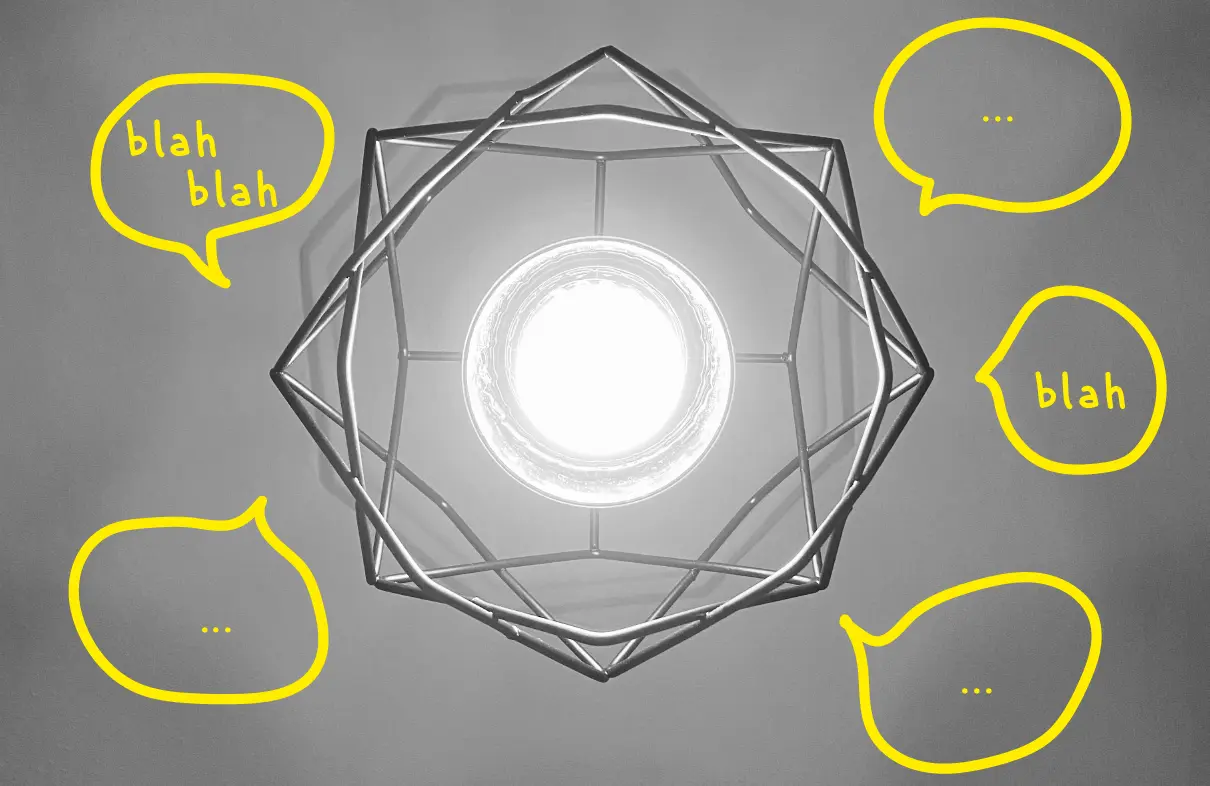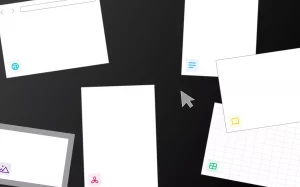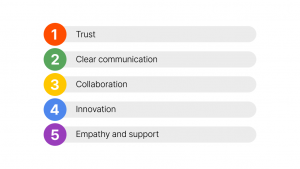How do we increase team productivity to the maximum?
This is a question that runs through the mind of every responsible team member. This question is essential to any team size, from a team of two to hundreds. As a business developer in a SaaS startup that is building a tool for teams called Typed, I repeatedly ask myself “What is the position of our product in the market? There are tools that label themselves as productivity tools, others as collaborative tools, or even more specifically real-time communication tools. I started to ponder about the relationship between these segments, more specifically, collaboration, productivity, and communication.
This essay is a written representation of my thought process disassembling the question: How are the three related to each other and how is current technology approaching related problems?
Defining the Relationship
Productivity
Productivity is defined as a measure of the efficiency of production, usually determined through the ratio between the output and input volume during a production process. The definition of productivity can be formulated as:
Productivity = Output/Input
This shows that productivity is a relative measure of the actual output of production compared to the actual input of resources. Based on the formula, productivity increases when a constant amount of input leads to an increase in output or when a constant output is produced by a decreasing amount of input. Productivity can be measured individually or as a team. However, team productivity is not simply an aggregation of the individual productivities of each team member, because there are more variables that have to be considered.
During a production process, work, an aggregation of all forms that affect the output volume directly or indirectly, is the input and the completion of a task is the final output. The output volume increases over time until the final output volume is reached, which is when the task is completed. The output volume increases as the amount of direct work done increases. On the other hand, indirect work is an action done in order to be able to execute direct work. An example would be the process of producing a research paper. The time and effort spent searching and collecting resources would be indirect work, while the actual act of writing the document would be direct work that increases the output volume. Classification of direct and indirect work depends on determining the task or goal. If the task is collecting research material, then time spent on research would be considered as direct work.
Productivity requires both an input and an output, which means it requires an action to be made and a change due to the action. In order to establish a relationship between productivity, collaboration, and communication, we have to determine where communication and collaboration goes in the formula of productivity.
Collaboration is a variable that has to be considered when determining team productivity. Collaboration is defined as the action of working with someone in order to complete a task. This corresponds with productivity because it relates to how well the team utilizes the input resources to produce the output. In other words, team productivity is a measure of how well a team collaborates. Hence, productivity can exist without collaboration, but collaboration cannot exist without productivity.
Collaboration and Communication Defined
Communication is defined as the exchange of information to achieve a better understanding. It is an issue in all areas of life that includes interaction between people. Even people in relationships face communication problems and it is only between two people! How much more if it’s between team members and cross-functional teams in workspaces. There are different forms of communication, such as verbal, written, and visual communication. All these different forms have a single purpose, delivering information to the intended person or group of people. Different ways of effectively communicating ideas and messages are continuously developed and created. The simpler the method, the better. An example would be Facebook’s ‘Relationship Status’, which is extremely simple, but considered to be revolutionary because it was a much more efficient way of telling others that you are single or that ‘it’s complicated.’ You would not have to ask around to find out if the person you are interested in has a significant other, but simply have to go on his or her Facebook profile. Effective communication methods require less time and effort when exchanging information.

Both communication and collaboration include the exchange of information, but the purpose differs between the two. The purpose of the exchange of information in communication is to achieve a better understanding, while in collaboration it is to advance the output volume. Both require a relationship to function between two or more people, but if the relationship does not lead to an increase in productive output, it is considered to be communication. Once the information exchanged between two or more individuals starts to be used to advance the group of people as a team towards a common goal, then communication becomes collaboration. Thus, communication can exist without collaboration, but collaboration cannot exist without communication.
All Three Together: Communication, Collaboration and Productivity.
To arrange all three entities into a single concept, communication and collaboration have to described using the terms used to define productivity. Productivity is defined using the two terms input and output. As mentioned in the previous section, communication does not lead to an increase in the productive output. Being able to deliver messages and exchange ideas more effectively over a shorter period of time would not be considered being more productive, unless it leads to an increase in the output volume. This would simply be a more efficient form of communication. Thus, communication is a part of the input of the productivity formula. If only communication exists, productivity would always be zero because the output value would be zero.
Collaboration on the other hand, requires the exchange of information to lead to an increase in the productive output. Collaboration is not simply the input in the formula of productivity, but covers both the input and output. In other words, if collaboration exists, both input and output exist, which means productivity exists as well. Hence, productivity cannot exist if collaboration does not exist and vice verse.

Figure 2 shows the production process from communication to output. Collaboration is a process and an increase in collaboration would be increasing the frequency of process. On the other hand, productivity is not the process, but is a measurement of the efficiency of the entire process. The process must be completed in order for productivity to exist because it requires the input and output volume. A part of communication in figure 2 is not part of collaboration, because not all of the communication done converts to work that in creases the productive output.
To increase productivity to its maximum, a team needs to convert more communication to collaboration. Communications that happen with no purpose related to increasing the productive output would decrease the efficiency and productivity of the team. The frequency of conversion can be increased as well by decreasing the time needed for the conversion to happen. This would require more effective and efficient methods of communication to exchange crucial information. Thus, the decrease in non-converted communication would increase the productivity of a team. Figure 3 below shows an increase in productivity as the amount of communication being covered by collaboration increases because this leads to a larger output to be produced.
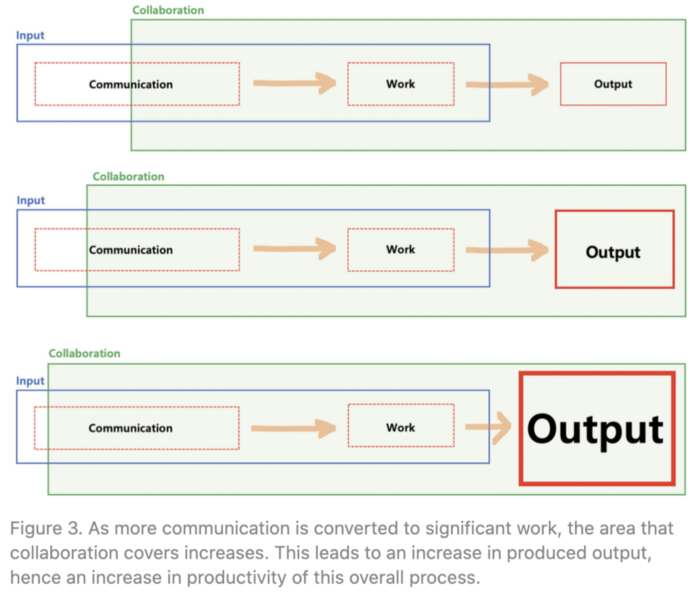
The complete conversion of communication to collaboration is a situation where every single exchange of information done by between team member leads to an increase of the common productive output. This would maximize the productivity of the team because it would produce the maximum output with the same resources used. However, this is almost impossible in reality, especially if the time frame is not a couple of minutes. People have other things to communicate about with members of the same team, such as what to have for lunch or how their weekend was. Each individual has other tasks that are not related to the collaborative work being done as well. Thus, communication methods, collaborative workspaces, rules, and protocols are made within a team to maximize collaboration at least for the allocated work-time.
Does this Apply to the Digital Workspace?
Currently digital transformation from physical to online workspaces has been inevitable due to the pandemic. This transformation has brought numerous advantages to teams, such as an increase in flexibility. However, too much flexibility and comfort can cause collaboration between team members to fall as well. Productivity and collaboration tools are continuously developed in order to solve these problems and as the rate of digital transformation increases, the development of these tools follow.
This has led to the exponential growth of the collaboration software market, with Salesforce’s acquisition of Slack towards the end of 2020 taking the spotlight. Team collaboration software range from cloud storage, synchronous documentation, messaging platforms all the way to knowledge bases. Although each software has a different core function, businesses integrate these collaborative tools in their digital workspaces for a single reason, to increase team productivity through more efficient communication methods. These tools increase the efficiency of communication by providing a method that enables users to deliver ideas, thoughts, and messages through a channel that requires less time and effort. However, as mentioned in the previous section, increasing efficiency of communication is not the end, but it must convert to collaboration. Tools that take collaboration to a higher level provide a platform or method that reduces the friction for users to apply the information exchanged through communication to work that increases the productive output. In other words, this is creating a workspace that naturally generates a seamless conversion from communication to collaboration. Thus, it is impossible to completely disconnect communication from collaboration in order for productivity to exist.

Based on the relationship between collaboration and productivity in the previous section, all collaboration tools are productivity tools as well. In order for collaboration to exist, productivity must exist, but not the other way around. This is because productivity is measurable even based on one individual, but collaboration requires at least two individuals working together. Productivity can be segmented into two major groups, individual productivity and team productivity. Tools that target team productivity are basically collaboration tools and a differentiation between the two would not make sense. There are tools that overlap between the segments in Figure 4, such as Asana, which would overlap between both collaboration and individual productivity because it can be used individually, but as a team as well.
Tools that aim to become an all-in-one solution in the collaboration market, they must be able to cover the entire process from communication to output, while increasing team productivity through increasing the frequency of communication being converted to significant work.
This is the end of my personal definition and relationship of the three terms, communication, collaboration, and productivity. From here on, it is a personal segmentation(based on figure 2) and a more detailed description of how current collaboration tools are trying to increase the conversion of communication to collaboration.
Slack
Slack has increased its number of DAU from 0.4 million to 12 million over the past 6 years, becoming one of the leading team collaboration softwares today. Slack dreams of becoming the central nervous system of collaboration between teams and cross-functional teams. They do not provide a native workplace for users, but create a space for team members to communicate using methods that they are familiar with; direct messaging and thread posts. In order to create an experience that is even more familiar, Slack allows users to use GIFs, making it extremely similar to social media applications people commonly use, but for work. Slack integrates other collaboration and task management tools, email, cloud storage etc., acting as a central API hub that connects cross-functional teams together. The familiarity of the user interface and integration of applications that are already being used by users provide a low barrier of entry for new users.
Slack incorporated their system into businesses at a fast rate, becoming the center of the gravity of project management. Whenever a team member wants to share their file, design, or links to resources, he or she would send it through Slack. Slack provides channels that allows categorization of threads, organizing the continuous ongoing communication between team members.
Slack and Collaboration
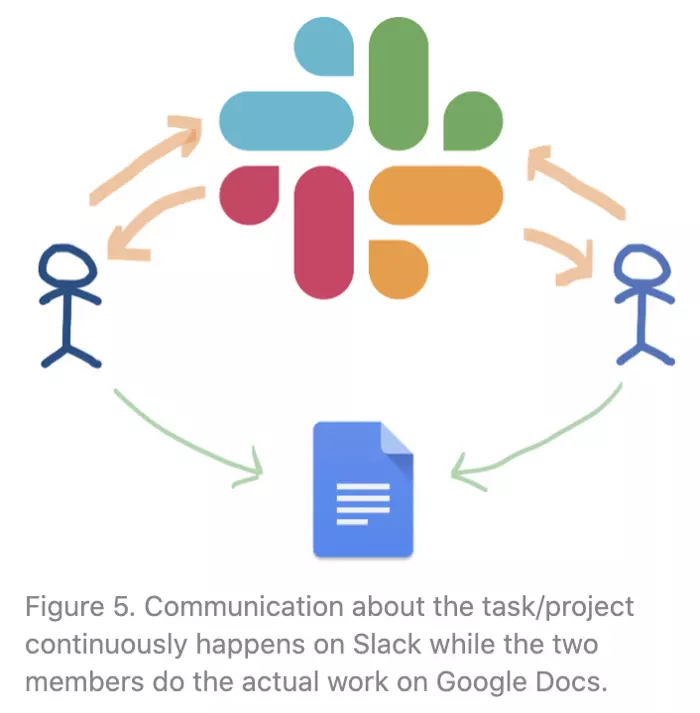
Figure 5 shows the overall process of Slack. The two team members use Slack to send links, references, ask questions, clarify parts about the task/project, share ideas, etc continuously as they do the actual work on Google Docs(Platform depends on the work). Based on the actions done on Slack, it can be defined as a hub for communication, which is only a segment of collaboration. This causes these individuals to rely on other applications for the parts of the collaboration process that Slack does not cover. Users have to switch back and forth from Google Docs to Slack whenever something is unclear and the two team members are not on the right track or when they need to previous files to make references.

Although Slack’s user familiar communication interface provides easy navigation and lowers the churn rate due to difficulties in learning a new platform, it prevents Slack form becoming a communication platform solely for work. Users start to have conversations that are not related to work because they are comfortable, increasing the amount of communication happening, but the amount of communication converting to actual work is stagnant. This decreases the productivity of the team as well as collaboration. Figure 4 shows that Slack takes a position in communication that is part of the collaboration process and communication that isn’t as well. In addition, it shows how Slack is not sufficient to call itself the “central collaboration hub,” because it only covers a small portion of the entire process. Central communication hub would fit its function more.
Figma: A Collaborative Workspace
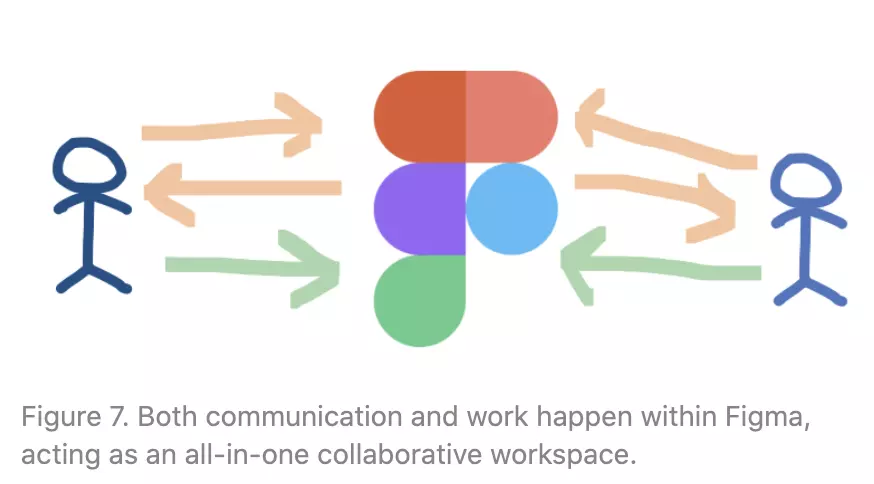
Figma was created with the purpose of providing a collaborative workspace for designers. Figma is browser-based, allowing it to work on any operating system that runs a browser. This feature lowers the barrier of entry for users and makes it more natural and easy for them to initially try using the platform. The collaboration features on Figma focus on reducing the friction designers face when they are working on a project as a team. Its synchronous workspace that allows real-time collaboration between multiple designers brought it to the surface of available design tools. When it comes to a project led by a single designer, then other features would have stronger influences on determining what software to use, but when it comes to team projects, collaboration is essential.
Figma’s Communication Methods: Better than Chat?
Figma’s synchronous workspace helps mitigate “design drifting,” which is when team members may misinterpret or stray from an agreed-upon design, through effective visual and intuitive communication. Team members are able to view what other members are working on and they can leave comments and make sure everyone is coordinated and on track. Figma does not only reduce the friction between designers collaborating together, but as well as the friction between designers and non-designers working on the same project. It’s web-based platform allows each of their files to have a URL link that can be sent to a member of another cross-functional team, giving access to the file that is continuously updated in real-time. This decreases the need to export the file whenever a change is made and having to convert between file types. When access to only a certain part of the file is given, Figma zooms into that certain page, automating the navigation process.

As mentioned previously, communication happens on different forms. Providing easy access to real-time collaboration between designers and even to non-designers is only a segment of Figma’s features that make it an effective tool. Figma provides a user-friendly interface that is self explanatory and usually does not require further communication between team members. Figma displays code snippets on any selected frame or object in CSS, iOS, or Android formats for developers to use when reviewing a design file. The design components can be inspected by any developer in any file they can view, reducing the need of further communication.
Figma allows teams to personalize the way they arrange their pages depending on the project and preferences. Some may arrange them based on platform or screen size(Android, iOS, desktop etc.), features of the app, or based on the progress of the project. In addition, team members can create a shared team library, keeping everyone on track with the latest updated version of files. This is crucial because not everyone works at the same time. The built-in versioning system also effectively keeps the team on track. At any time, a designer can create a named version and description of a Figma file; this can be done immediately after agreed changes are made to a design. These features and designs of the user interface of Figma are all ways of communicating, such as version updates, page arrangements, code snippets, commenting, and file sharing. The more effective they are, the less users would have to use Slack, email, or other communicating methods. Hence, majority of the collaboration process is done on Figma, which reduces unnecessary communication, increasing the productivity of the team.
Figma provides a chat plugin, but our team’s designers don’t even use it because no further communication is needed!
Google Docs: How Well are they Doing?
Google Docs is one of the most used real-time collaboration documentation tool today. It is browser-based as well, like Figma, and allows users to create, edit, and share documents online with other team members. Version history, chat, and comments are forms of communication between team members collaborating in Google Docs.
The version history of Google Docs provides users with the ability to revert or retrieve any lost information from past versions. This as well provides team members with information on which member contributed to what parts of the document. This is possible because Google Docs has an auto-save feature that saves the document as long as the user has connection to the Internet. However, when collaborating on documents, especially projects that require a lot of editing and updates, having a version management system that simply creates a version whenever a change occurs is not effective. This makes it difficult for members collaborating on the document determine what changes are significant. The members can save a new version of the file whenever a significant change has been made, but then they would have to communicate that they did to all the other members. This could also lead to members of the team working on different documents as the number of versions increase.
This is an outcome of miscommunication, hence the time wasted would be included as time used for communication since the message hasn’t been delivered(the message in this case would be the most current version). This would lead to the team having to communicate through email or Slack that a new version been updated.

The chatting system of Google Docs allows team members working on the same document to communicate with each other, but it is not effective unless all members are working on the document. However, chat is a feature that collaboration tools should work on last. If all the other features are effective forms of communication, a business made up of cross-functional teams would not need to chat when working as long as they have effective meetings and collaborative digital workspaces.
Comments allow team members to coordinate other members by specifically adding the comments on the section of the document by tagging specific users. However, it is not possible to tag a collaborator by their name if the user does not have their information on Google contacts. This can make it difficult to use the tag feature to call out individuals specifically, especially when people from other cross-functional teams are given access to review the document. In addition, as the number of comments increase, the interface becomes more cluttered, hindering visibility. Using the comment feature is the closest to task management on Google Docs, but it is not as efficient as using a project management tool(e.g. Asana).
In order for Google Docs to step up their game in becoming the best document-based collaboration tool, they have to develop a form of communication that tells users what updates have been made, what the current version is, and what tasks they are specifically given. A visual representation of the information would be most effective since a picture is worth a thousand words.
